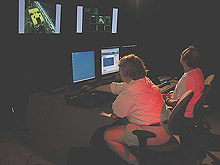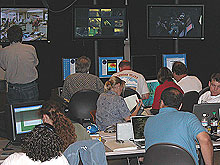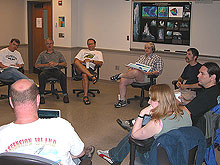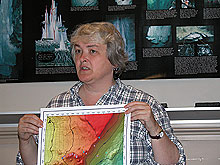
Brennan Phillips, UCONN graduate student and Argus pilot/engineer for IFE, secures crab traps to one of the elevators in the foreground, while Chief Bosun, Bruce Cowden works on elevator floats in the background. Click image for larger view and image credit.
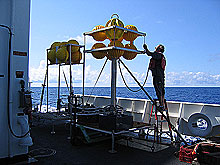
Chief Bosun, Bruce Cowden secures large floatation balls to the frame of one of the elevators. Each floatation ball weighs about 60 pounds in air and has a lift of about 37 pounds in water. Click image for larger view and image credit.
AT SEA AND ON LAND
July 22, 2005
Deb Zeyen
The first exploration dive is planned for tomorrow so scientists and technicians are in high gear today. Here's a few snapshots of what's going on.
As the Ronald H. Brown cruises towards the Mid-Atlantic Ridge, technicians and scientists prepare for the first dive.
On the Ronald H. Brown work platforms are prepared to be put in the water. These platforms, called elevators, are used in various types of deep ocean work to transport tools to the seafloor, and also to bring samples up from depth. Three elevators will be used on this cruise. One has been fitted with crab traps and will be placed in an area where scientists think they may have the most luck in collecting organisms such as crabs and fish. The 'trap' elevator will be left in place for the duration of a dive and scientists will periodically view it from the ROV cameras to see if they have successfully collected organisms. The other two elevators will be used to transport tools and samples. The two 'transport' elevators will periodically be sent to the surface so that samples can be retrieved and preserved on board. All three elevators will be fitted with transponders so that the science team on board will be able to track their positions. As they are weighted heavily to sink to the bottom, they are also fitted with large floatation balls to bring them back to the surface once the weights are released acoustically from the ship.
Meanwhile at the University of Washington scientists gather at the Science Control Center. In the picture are two of the three flat screens that carry images from the NOAA ship Ronald H. Brown. The scientists in this control room will see images from the ROV as it explores the chimneys of Lost City near the Mid-Atlantic Ridge. Images will be transmitted from the seafloor to the ship and then to the scientists at UW in less than 1 second. Data such as water temperature, depth, salinity, and precise location will be fed 'live' to the control room. A group of over 20 scientists will be able to analyze the images and data as it arrives in 'real time'.
At today's science meeting many topics were covered. The 'watch' chart was developed. Since the exploration will be live 24 hours a day during all 10 days of the underwater exploration, a lead scientist, logger and video operator are assigned for 6-hour shifts. The lead scientist will communicate with the ROV pilots aboard the ship. The logger will keep careful notes of time, location, description, and water conditions of selected images. The video operator will record selected images to be recorded for immediate use. The scientists reviewed the protocol for navigation of the ROV and sampling. Scientists will visually inspect each sample of rock or biological sample extracted, sketch it, record the sample bin it was assigned and review the storage and logging of the sample with the ship crew. Certain samples will be frozen immediately to assure they remain in tact and for preservation of organisms. Scientists shared their priorities with each other. The scientist on duty must know the images and samples another scientist will need.
Sign up for the Ocean Explorer E-mail Update List.



























